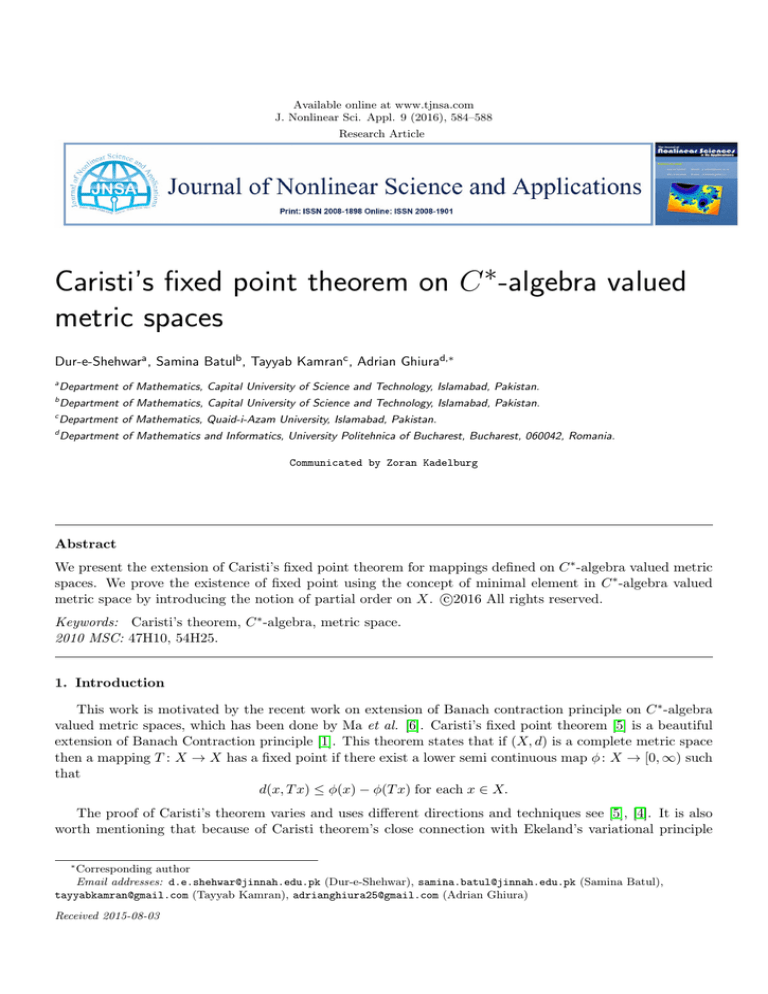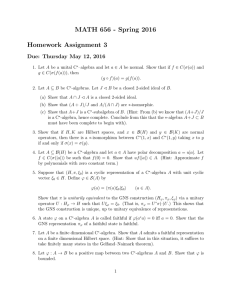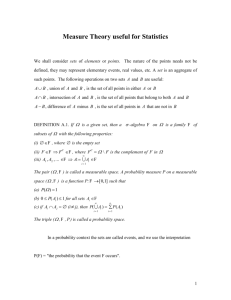
Available online at www.tjnsa.com
J. Nonlinear Sci. Appl. 9 (2016), 584–588
Research Article
Caristi’s fixed point theorem on C ∗-algebra valued
metric spaces
Dur-e-Shehwara , Samina Batulb , Tayyab Kamranc , Adrian Ghiurad,∗
a
Department of Mathematics, Capital University of Science and Technology, Islamabad, Pakistan.
b
Department of Mathematics, Capital University of Science and Technology, Islamabad, Pakistan.
c
Department of Mathematics, Quaid-i-Azam University, Islamabad, Pakistan.
d
Department of Mathematics and Informatics, University Politehnica of Bucharest, Bucharest, 060042, Romania.
Communicated by Zoran Kadelburg
Abstract
We present the extension of Caristi’s fixed point theorem for mappings defined on C ∗ -algebra valued metric
spaces. We prove the existence of fixed point using the concept of minimal element in C ∗ -algebra valued
c
metric space by introducing the notion of partial order on X. 2016
All rights reserved.
Keywords: Caristi’s theorem, C ∗ -algebra, metric space.
2010 MSC: 47H10, 54H25.
1. Introduction
This work is motivated by the recent work on extension of Banach contraction principle on C ∗ -algebra
valued metric spaces, which has been done by Ma et al. [6]. Caristi’s fixed point theorem [5] is a beautiful
extension of Banach Contraction principle [1]. This theorem states that if (X, d) is a complete metric space
then a mapping T : X → X has a fixed point if there exist a lower semi continuous map φ : X → [0, ∞) such
that
d(x, T x) ≤ φ(x) − φ(T x) for each x ∈ X.
The proof of Caristi’s theorem varies and uses different directions and techniques see [5], [4]. It is also
worth mentioning that because of Caristi theorem’s close connection with Ekeland’s variational principle
∗
Corresponding author
Email addresses: d.e.shehwar@jinnah.edu.pk (Dur-e-Shehwar), samina.batul@jinnah.edu.pk (Samina Batul),
tayyabkamran@gmail.com (Tayyab Kamran), adrianghiura25@gmail.com (Adrian Ghiura)
Received 2015-08-03
D. Shehwar, S. Batul, T. Kamran, A. Ghiura, J. Nonlinear Sci. Appl. 9 (2016), 584–588
585
[3] many authors refer it to as Caristi-Ekeland fixed point result. Several authors extended this result on
different type of distance spaces for example in [4]. Khamsi gave a characterization to the existence of
minimal element in a partially ordered set in terms of fixed point of multivalued map. Then he showed how
Caristi’s theorem may be characterized.
In this paper we introduce the notion of lower semi continuity in the context of C ∗ -algebra valued metric
spaces [6]. Also, we define a partial order on C ∗ -algebra valued metric space. Taking advantage offered by
this framework, we extend the Caristi’s fixed point theorem in context of C ∗ -algebra valued metric space.
2. Preliminaries
We now recollect some basic definitions, notations, and results that will be used subsequently. For the
details, we refer to [2], [7].
An algebra A together with a conjugate linear involution map ∗ : A → A defined by a 7→ a∗ such that
for all a, b ∈ A we have (ab)∗ = b∗ a∗ and (a∗ )∗ = a, is called a ∗-algebra. Moreover, if A contains an
identity element 1A then the pair (A, ∗) is called a unital ∗-algebra. A unital ∗-algebra (A, ∗) together with
a complete sub multiplicative norm satisfying ka∗ k = kak for all a ∈ A is called a Banach ∗-algebra. A
C ∗ -algebra is a Banach ∗-algebra (A, ∗) such that ka∗ ak = kak2 for all a ∈ A. An element a ∈ A is called a
positive element if a = a∗ and σ(a) ⊂ R+ , where σ(a) = {λ ∈ R : λ1A − a is non invertible}. If a ∈ A is
positive, we write it as a 0A . Using positive elements, one can define a partial ordering on A as follows:
b a if and only if b − a 0A . Each positive element a of a C ∗ -algebra A has a unique positive square
root. Subsequently, A will denote a unital C ∗ -algebra with the identity element 1A . Further, A+ is the set
{a ∈ A : a 0A } of positive elements of A and (a∗ a)1/2 = |a|.
Using the concept of positive elements in A, a C ∗ -algebra valued metric space is defined in the following
way [6].
Definition 2.1. Let X be a non-empty set. A C ∗ -algebra valued metric on X is a mapping d : X × X → A
satisfying the following conditions:
(i)
(ii)
(iii)
0A d(x, y) for all x, y ∈ X and d(x, y) = 0A ⇔ x = y;
d(x, y) = d(y, x) ∀x, y ∈ X;
d(x, y) d(x, z) + d(z, y) ∀x, y, z ∈ X.
The triplet (X, A, d) is called a C ∗ -algebra valued metric space.
Remark 2.2. The set of positive elements in a C ∗ -algebra forms a positive cone in the C ∗ -algebra but the
underlying vector space need not to be, in general, a real vector space. For example, let A be the set of
all 2 × 2 matrices having entries from complex numbers, then A is a vector space over the field of complex
numbers. Therefore, the notion of a C ∗ -valued metric space seems to be general than the notion of a cone
metric space.
Definition 2.3. A sequence {xn } in (X, A, d) is said to converges to x ∈ X with respect to A, if for any
> 0 there exists N ∈ N such that kd(xn , x)k < , for all n > N . We write it as limn→∞ xn = x.
Definition 2.4. A sequence {xn } is called a Cauchy sequence with respect to A if for any > 0 there exists
N ∈ N such that kd(xn , xm )k < for all n, m > N .
The triplet (X, A, d) is said to be a complete C ∗ -algebra valued metric space if every Cauchy sequence
with respect to A is convergent.
Definition 2.5. Let(X, A, d) be a C ∗ -algebra valued metric space.
A mapping T : X → X is said to be a C ∗ -valued contraction [6] mapping on X if there exist an a ∈ A
with kak < 1 such that
d(T x, T y) a∗ d(x, y)a, for all x, y ∈ X.
(2.1)
D. Shehwar, S. Batul, T. Kamran, A. Ghiura, J. Nonlinear Sci. Appl. 9 (2016), 584–588
586
3. Main Results
We begin this section by introducing the notion of lower semi continuity in the context of C ∗ -algebra
valued metric spaces.
Definition 3.1. Let (X, A, d) be a C ∗ -algebra valued metric space. A mapping φ : X → A is said to be
lower semi continuous at x0 with respect to A if
kφ(x0 )k ≤ lim inf kφ(x)k.
x→x0
Example 3.2. Let X = [−1, 1] and A = R2 be the C ∗ -algebra with k(a1 , a2 )k =
order on A as follows:
(x1 , y1 ) (x2 , y2 ) ⇔ x1 ≤ x2 and y1 ≤ y2 ,
p
|a1 |2 + |a2 |2 . Define an
where “≤” is the usual order on the elements of R. It is easy to see that is a partial order on A+ . Consider
d : X × X → A defined by d(x, y) = (|x − y|, 0),then clearly (X, A, d) is a C ∗ -algebra valued metric space.
Define a map
( x
( , 0) if x ≥ 0
2
φ : X → A, φ(x) =
(1, 0) otherwise.
Then it is easy to see that φ is lower semi continuous at x0 = 0.
It is straightforward to prove the following lemma.
Lemma 3.3. Let (X, A, d) be a C ∗ -algebra valued metric space and let φ : X → A+ be a map. Define the
order φ on X by
x φ y ⇐⇒ d(x, y) φ(y) − φ(x) for any x, y ∈ X.
(3.1)
Then φ is a partial order on X.
Theorem 3.4. Let (X, A, d) be a complete C ∗ -algebra valued metric space and φ : X → A+ be a lower
semi-continuous map. Then (X, φ ) has a minimal element, where φ is defined by (3.1).
Proof. Let x1 φ x2 φ x3 φ · · · be a non-increasing sequence in X, then from (3.1) we have
oA d(x2 , x1 ) φ(x1 ) − φ(x2 ), oA d(x3 , x2 ) φ(x2 ) − φ(x3 ), . . .
⇒ φ(x1 ) φ(x2 ) φ(x3 ) . . . .
Hence {φ(xα ) : α ∈ I} is a decreasing chain in A+ , where I is an indexing set.
Let {αn } be an increasing sequence of elements from the indexing set I such that
lim φ(xαn ) = inf{φ(xα ) : α ∈ I}.
n→∞
Take m > n then xαn φ xαm . It follows from (3.1) that
d(xαm , xαn ) φ(xαn ) − φ(xαm )
⇒ kd(xαm , xαn )k ≤ kφ(xαn ) − φ(xαm )k,
taking lim n → ∞ then together with (3.2), it further implies that
lim kd(xαm , xαn )k ≤ lim kφ(xαn ) − φ(xαm )k
n→∞
n→∞
= k inf{φ(xα ) : α ∈ I} − inf{φ(xα ) : α ∈ I}k
= 0.
(3.2)
D. Shehwar, S. Batul, T. Kamran, A. Ghiura, J. Nonlinear Sci. Appl. 9 (2016), 584–588
587
Therefore {xαn } is a Cauchy sequence in X by (2.4). As X is complete, there exists x ∈ X such that
xαn → x. Since {xαn } is decreasing chain in X, it follows that x φ xαn for all n ≥ 1. This implies that x
is a lower bound for {xαn }n≥1 .
We claim that x is a lower bound for {xα }α∈I .
Let β ∈ I be such that xβ φ xαn for all n ≥ 1. Then
0A d(xαn , xβ ) φ(xαn ) − φ(xβ ).
Taking limit n → ∞ implies
φ(xβ ) inf {φ(xα ) : α ∈ I}.
(3.3)
inf {φ(xα ) : α ∈ I} φ(xβ ).
(3.4)
inf {φ(xα ) : α ∈ I} = φ(xβ ).
(3.5)
Since β ∈ I, we have
Combining (3.3) and (3.4) we get
As xβ φ xαn it follows from (3.1) that d(xβ , xαn ) φ(xαn ) − φ(xβ ). Using (3.5) and the fact that {xαn }
is decreasing chain in X we get
0A d( lim xαn , xβ ) lim φ(xαn ) − φ(xβ ) = φ(xβ ) − φ(xβ ) = 0A .
n→∞
n→∞
Thus
d( lim xαn , xβ ) = 0A .
n→∞
Hence limn→∞ xαn = xβ . It follows from the uniqueness of limit that xβ = x. That is, x is a lower bound
of {xα : α ∈ I}. Hence by using Zorn’s Lemma we conclude that X has a minimal element.
As a consequence of the above theorem we have the following fixed-point result.
Theorem 3.5. Let (X, A, d) be a complete C ∗ -algebra valued metric space and φ : X → A+ be a lower semi
continuous map. Let T : X → X be such that for all x ∈ X
d(x, T x) φ(x) − φ(T x).
(3.6)
Then T has at least one fixed point.
Proof. Let a ∈ X be a minimal element of X. Since T a ∈ X, it follows that a φ x for all x ∈ X in
particular
a φ T a.
(3.7)
By combining (3.7) and the condition (3.6) we have T a = a, that is T has a fixed point.
Example 3.6. Let X = [0, 1] and A = R2 be a C ∗ -algebra with the partial order as given in Example 3.2.
Define d : X × X → A by d(x, y) = (|x − y|, 0). Let φ : X → A+ , φ(x) = (x, 0) be continuous map, and
T : X → X given by the formula T (x) = x2 . Then it is easy to see that all the conditions of Theorem 3.5
are satisfied and T has a fixed point. Note that contractive theorem stated in [6] is not applicable here,
since contractive condition (2.1) does not hold.
4. Conclusions
In this paper, we presented an extension of Caristi’s fixed point theorem for mappings defined on C ∗ algebra valued metric spaces. We proved the existence of fixed point using the concept of minimal element
in C ∗ -algebra valued metric space by introducing the notion of partial order on X.
D. Shehwar, S. Batul, T. Kamran, A. Ghiura, J. Nonlinear Sci. Appl. 9 (2016), 584–588
588
References
[1] S. Banach, Sur les opérations dans les ensembles abstraits et leurs applications aux équations intégrals, Fund.
Math., 3 (1922), 133–181. 1
[2] K. R. Davidson, C ∗ -Algebras by Example, Fields Institute Monographs 6, American Mathematical Society, Providence, RI, (1996). 2
[3] I. Ekeland, Sur les probelems variationnels, C. R. Acad. Sci. Paris, 275 (1972), 1057–1059. 1
[4] M. A. Khamsi, Remarks on Carisit’s fixed point theorem, Nonlinear Anal., 71 (2009), 227–231. 1
[5] M. A. Khamsi, W. A. Kirk, An Introduction to Metric Spaces and Fixed Point Theory, Wiley, New York, (2001).
1
[6] Z. Ma, L. Jiang, H. Sun, C ∗ -algebra valued metric spaces and related fixed point theorems, Fixed Point Theory
Appl., 2014 (2014), 11 pages. 1, 2, 2.5, 3.6
[7] G. J. Murphy, C ∗ -Algebras and Operator Theory, Academic Press, Boston, (1990). 2



